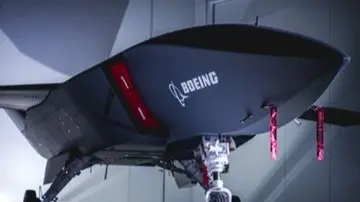Updated 21 March 2025 at 22:33 IST
Boeing Wins Contract for US Air Force’s Next-Gen Fighter Jet F-47
The F-47 is designed to replace the F-22 and will operate alongside highly advanced drone wingmen as part of the Air Force’s NGAD initiative.
- World News
- 3 min read

Boeing has been selected to develop the U.S. Air Force’s highly anticipated F-47 fighter jet, a key part of the Next Generation Air Dominance (NGAD) program. President Donald Trump announced the decision in an Oval Office address on Friday, calling the F-47 “a beautiful number” and touting the project as a major step forward for American air superiority.
The decision marks a significant win for Boeing, which has struggled in both defense and commercial sectors in recent years. It also deals a blow to Lockheed Martin, the maker of the widely used F-35 fighter, which had been competing for the contract.
A fighter for the future
The F-47 is designed to replace the F-22 and will operate alongside highly advanced drone wingmen as part of the Air Force’s NGAD initiative. The program envisions sixth-generation fighters that integrate cutting-edge stealth, sensor, and engine technologies.
According to a report from CBS News, it will be equipped with AI assisted targeting and pilot support systems, stealth coating that dynamically responds to RADAR and thermal detection, quantum encrypted communication systems, multi-domain sensor fusion, directed energy systems and hypersonic weapons.
Advertisement
Alongside Boeing’s role in producing the main aircraft, companies like Anduril Industries and General Atomics are developing the semi-autonomous drones that will work in coordination with the F-47 in combat.
The Air Force has deemed NGAD essential for maintaining an edge over global adversaries, particularly China, which has been rapidly advancing its own military aircraft technology.
Advertisement
Trump’s announcement and military support
Trump, flanked by a rendering of the NGAD fighter, emphasized the importance of the new program. “The F-47 will be the most advanced fighter jet ever built, a game-changer for American airpower,” he declared. Defense Secretary Pete Hegseth was also present for the announcement, reinforcing the Pentagon’s commitment to the initiative.
Air Force Chief of Staff Gen. David Allvin recently reaffirmed the necessity of the NGAD program, saying in an interview that he was “convinced from the analysis that NGAD is necessary.”
The cost challenge
Despite the excitement surrounding the F-47, the program’s cost has been a major point of debate. Initial estimates suggested each aircraft could cost around $300 million—a figure that former Air Force Secretary Frank Kendall considered too high. He had expressed interest in lowering costs to around $80-100 million per jet.
China’s growing military strength
The Pentagon’s selection of Boeing comes at a time when China is rapidly expanding its air power. Late last year, China unveiled three new aircraft, including a next-generation fighter and an advanced airborne early-warning plane. The U.S. Department of Defense has warned that China is building up its air fleet with domestically produced aircraft and a growing arsenal of drones.
If tensions in the Indo-Pacific escalate, the U.S. military will need a combination of advanced manned and unmanned aircraft to maintain superiority. The F-47, alongside its drone counterparts, is expected to play a crucial role in future conflicts.
Looking ahead
The F-47 program represents a major shift in American air combat strategy, integrating manned and unmanned systems like never before. While the program still faces challenges in terms of cost and design, the Pentagon’s selection of Boeing signals a clear commitment to pushing forward with the next generation of fighter aircraft.
With development now officially underway, the U.S. Air Force is preparing to field the F-47 in the 2030s, ensuring that American pilots—and their robotic wingmen—remain dominant in the skies.
Published By : Sagar Kar
Published On: 21 March 2025 at 22:33 IST
